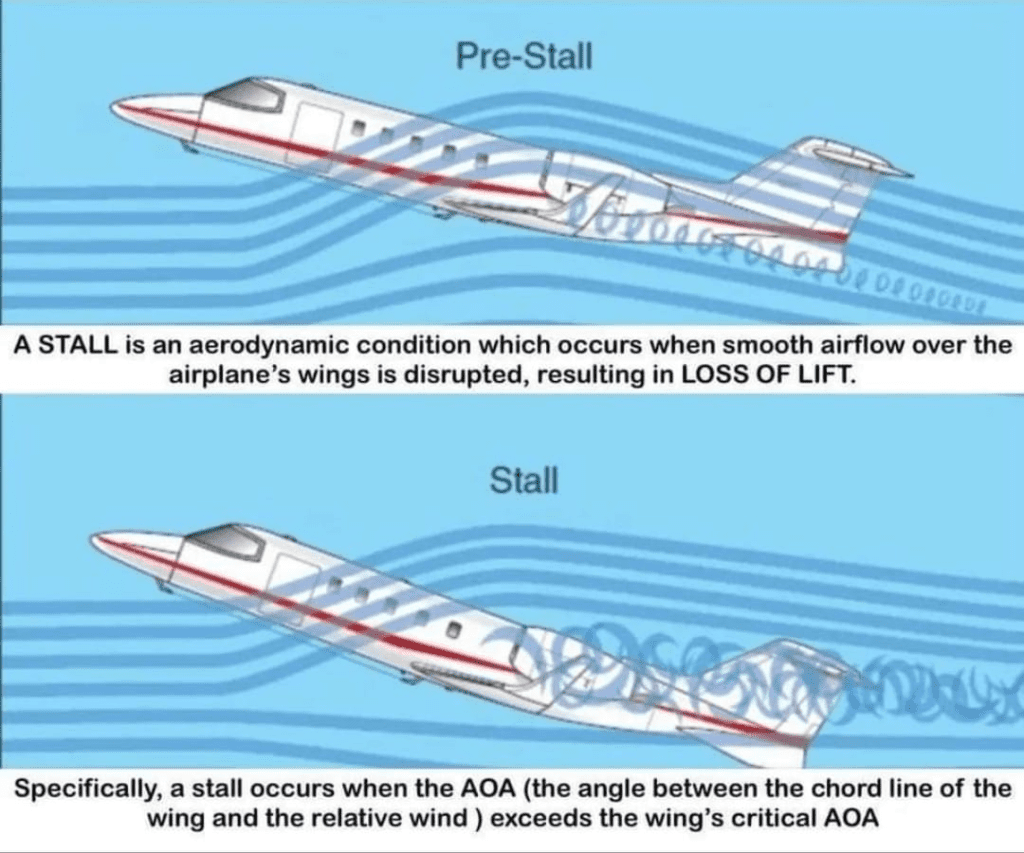
Definition
Stall is defined as a sudden reduction in the lift generated by an aerofoil when the critical angle of attack is reached or exceeded.
Description
A stall occurs when the angle of attack of an aerofoil exceeds the value which creates maximum lift as a consequence of airflow across it. This angle varies very little in response to the cross section of the (clean) aerofoil and is typically around 15°. At the stall, the airflow across the upper cambered surface ceases to flow smoothly and in contact with the upper surface and becomes turbulent, thus greatly reducing lift and increasing drag. Changing the effective configuration of a wing by the deployment of leading edge or trailing edge devices will directly alter the angle of attack at which an aerofoil stalls. However, all this assumes a clean wing and for any aerofoil, contamination of the normally smooth surface by frozen deposits will result in a change to the angle of attack at which a stall will occur.
The Angle of Attack of an aerofoil – the incidence of the wing to the incident airflow – is not the same as the pitch attitude of the aircraft as displayed on the corresponding primary flight instrument and many aircraft do not have an instrument which displays angle of attack. However, when flying straight and level with a particular aircraft mass and prevailing density altitude, for every wing angle of attack there is a corresponding indicated air speed. Because of this, the indicated airspeed at which an aircraft has been shown to stall in given circumstances is determined during aircraft certification and included in the AFM. This indicated speed, Vs, provides a fundamental reference for all other AFM aeroplane performance calculations which involve indicated airspeed and helps define the Flight Envelope for each aircraft type and variant.
The indicated speed at which a particular aircraft operating at a particular total weight will stall when in straight and level flight at a given air density (which broadly corresponds to altitude) will not be very different for the climb and descent case at that air density – but it will increase as bank angle increases since in a turn, the lift from the wing must exceed the weight being supported. As air density decreases with increasing altitude, more lift must be generated by an aerofoil to sustain flight and so the true air speed at which an aerofoil will stall will increase. However, this fact is not of direct relevance to the pilot since the airspeed displayed is indicated air speed derived from the ambient air density. Thus, the indicated speed at which an aircraft will stall will be the same at any altitude.
On a propeller driven aircraft with engines ahead of the wing, the slipstream from each engine can change the angle of attack for the area of the wing that it affects, when compared with the angle of attack of those parts of the wing in the free airflow. Thus the wing will stall in parts, not all at once. Therefore, the power set, and the resulting slipstream effects, will change the speed at which stalling becomes apparent in any particular configuration.
Stall Awareness
A stalled wing may be accompanied by one or more of the following:
Buffet
Poor pitch authority.
Poor roll control.
An inability to arrest descent.
On all transport aircraft, some form of stall protection system is a certification requirement. Such a system is likely to incorporate stall warning based on the continuous direct measurement of angle of attack moderated by wing configuration in order to enable recovery from an incipient or approaching stall. For aircraft with a conventional control column, this usually includes a stick shaker which provides tactile as well as aural alerting. At the onset of a full stall, most stall protection systems activate a stick pusher to ensure that aircraft pitch attitude (which although it is not directly related to angle of attack varies in the same relative sense) is automatically reduced as an essential component of recovery to safe flight.
It is important to note that stall protection systems cannot take account of the possible effects of contaminated aerofoil surfaces and also that any such contamination may not necessarily be symmetrical in respect of the overall aircraft. It should also be noted that on modern Fly-By-Wire aeroplanes, the stall protection system has become part of a wider Flight Envelope Protection System.
Author – Vander Stone




